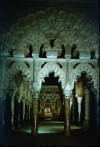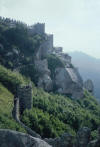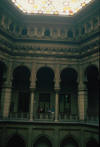|
Moorish Architecture (Spanish-Islamic) "In 750, only one
Umayyad notable, Abd-al-Rahman I, escaped the Abbasid
massacre of his clan in Syria. He fled to Spain,
where, ... the Arabs had overthrown the Christian kingdom of
the Visigoths in 711. The Arab military governors of
the peninsula accepted the fugitive as their overlord, and
he founded the Spanish Umayyad dynasty, which lasted for
almost three centuries. The capital of the Spanish
Umayyads was Cordoba, which became the center of a brilliant
culture rivaling that of the Abbasids at Baghdad and
exerting a major influence on the civilization of the
Christian West."
- Gardner's
Art Through The Ages,
11th edition, Vol. I, p. 367
Hall of the
Ambassadors in the Alcazar, Seville
 And from
outside looking in: And from
outside looking in:

Cupola in the Hall of the Ambassadors, The Alcazar, Seville,
Spain

La Giralda, Seville, Spain

"The jewel of the capital at
Cordoba was its Great Mosque, begun in 784 and enlarged
several times during the ninth and tenth centuries. It
eventually became the largest mosque in the Islamic West.
The additions followed the original style and arrangement of
columns and arches, and the builders maintained a striking
stylistic unity for the entire building. The hypostyle
prayer hall has thirty-six piers and five-hundred fourteen
columns topped by a unique system of double-tiered arches.
The lower arches are horseshoe shaped, a form perhaps
adapted from earlier Near Eastern architecture or of
Visigothic origin. The horseshoe arch quickly became
closely associated with Muslim architecture. Visually,
these arches seem to billow out like sails blown by the
wind, and they contribute greatly to the light and airy
effect of the mosque's interior."
- Gardner's
Art Through The Ages,
11th edition, Vol. I, pp. 367 - 369
An Interior
View in the Grand Mosque, Cordoba, Spain

Fortifications (Moorish
Walls), Sintra, Portugal
 and another view:
and another view:

**************************************************
Islamic Architecture
in the Balkans
Former City View of Sarajevo
**

Former Fountain of Sarajevo's Principal Mosque (Gavi Husrev
Begova)

Interior of Gavi-Husrev Begova

Former
Library/Townhall in Sarajevo (19th c. Neo-Moorish)
 (Photo credit: R. Borneman, 1989)
(Photo credit: R. Borneman, 1989)
|